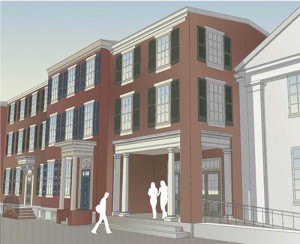Architect’s plans for historic building wins over most critics
By Kathleen Brady Shea Managing Editor, UnionvilleTimes.com
WEST CHESTER — For nearly six years, a controversy over a historic West Chester church’s expansion generated rhetoric that could politely be termed un-Christian.
But reconciliation finally prevailed last night at West Chester Borough Council, where a settlement closing the door on protracted litigation passed by a 6-1 vote – after a brief, threatened derailment over a door.
Bill Scott, a preservation activist, urged the First Presbyterian Church of West Chester, designed in 1834 by the renowned Greek Revival architect Thomas U. Walter, to incorporate the entrance of a 19th-century rowhome slated for demolition into the new façade. He was joined in his plea by Councilman Jordan Norley, who cast the dissenting vote.
Bob Adams, the church’s attorney, explained that after careful analysis, the project’s architect, John Milner, well-known for championing period authenticity, concluded that the door and its architrave represented a hodge-podge of three architectural styles. It would “trivialize the overall design,” Adams said, adding that he was confident the door could be used elsewhere in the addition.
Despite the detour, everyone agreed that the church deserved to be commended for its efforts to resolve the conflict, which began in 2006 after the church bought two contiguous mid-19th-century rowhouses on West Miner Street for a planned addition and promised not to destroy them. “The church came 100 miles in our direction,” Scott acknowledged.
The church’s expansion plan initially ran afoul of borough ordinances, particularly over parking. The church threatened to sue if the borough did not change the ordinances, which it eventually did. But by 2010, the controversy reignited when the church introduced a plan to add 18,000 square feet to the church’s 44,000 that included the demolition of both historic rowhomes, producing what many viewed as a white stucco behemoth on the block.
Neighbors of the church, which occupies a corner of Darlington and Miner Streets in a dense, residential area, accused the church of reneging on its promise to save the rowhomes. They suggested that many of the congregants had no compunctions about ruining the streetscape of a block frequently showcased on walking tours because they returned to homes in townships such as East Bradford and Birmingham.
Not true, the church responded. Some members publicly sided with the opponents of the expansion and vowed to come up with a more harmonious solution. In December 2010, West Chester Borough Council rejected the church’s land-development plan, a decision the church appealed. But less than a year later, Milner had plans on the drawing board designed for rapprochement.
Although the new design saves only one of the rowhomes, it reduces the scale of the addition by creating three brick townhouses consistent with the style of the block “that will conceal the rest of the large addition behind them,” Milner wrote.
Despite a substantially higher cost, Adams said the church much prefers the new configuration. “We’re just thrilled with the way this is going to come out,” he said, adding that the timetable for construction is not set and will depend on the church’s fund-raising.
The church’s paster, the Rev. Greg Stovell, expressed gratitude and relief after the vote. He started at the church in the middle of the fray and immediately espoused peace-making.
“We’re very grateful,” he said. “I’m pleased the Council appreciated all the church has done.”







